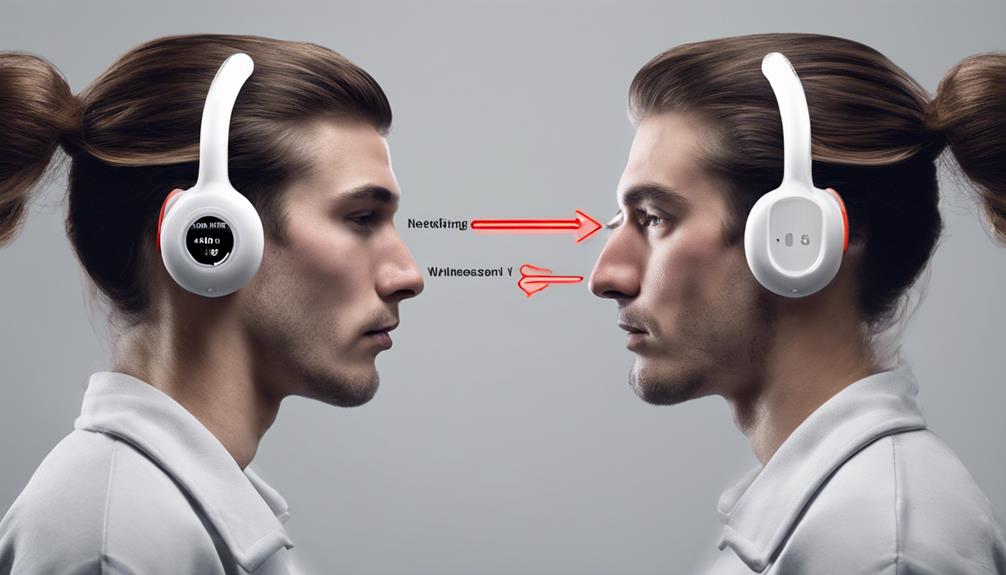Let’s talk about the subtle impacts AirPods can have on our hearing health. While they may be comfortable and convenient, it is important to acknowledge the potential risks they pose.
Understanding how prolonged exposure to high decibel levels can affect our ears is crucial. But that's just the beginning of the story.
Let's explore how we can safeguard our hearing without missing out on our favorite tunes – there's more to this than meets the eye.
Key Takeaways
- Monitoring volume levels below 70 dB is crucial for preventing AirPods-induced hearing loss.
- Implementing the 60/60 rule reduces the risk of ear damage from prolonged high-volume exposure.
- Utilizing noise-canceling features can help maintain safe listening habits and protect hearing health.
- Taking breaks and using over-ear headphones promote healthier listening practices to safeguard against hearing issues.
Understanding Decibel Levels and AirPods
Understanding the decibel levels associated with AirPods is crucial for maintaining optimal hearing health and preventing potential damage. AirPods have the capability to reach volumes exceeding 100dB, which can lead to irreversible hearing damage if exposure is prolonged. It's essential to grasp the safe listening range for AirPods, typically recommended in the 60s or 70s dB, to safeguard our ears.
Background noise can often prompt individuals to increase the volume on their AirPods, unknowingly putting themselves at risk of surpassing safe decibel levels. By comprehending the decibel levels at which AirPods operate and the potential harm they can cause, users can make informed decisions regarding their listening habits. This understanding empowers individuals to take proactive measures in preventing hearing damage while still enjoying the convenience of wireless headphones. Remember, knowledge is key in maintaining healthy hearing when using AirPods.
Monitoring Volume Levels for Hearing Safety

Monitoring volume levels on AirPods is crucial for safeguarding our hearing health and preventing potential damage. Here are three key points to consider in maintaining safe listening habits:
- Regularly Check Volume Settings: Make it a habit to periodically check the volume levels on your AirPods. Adjusting the volume to a safe range between 60-70 dB can significantly reduce the risk of hearing damage.
- Understand the Impact: Educate yourself on how high volume levels can impact your ears. Being aware of the potential consequences can motivate you to be more mindful of your listening habits.
- Prioritize Prevention: Prevention is key when it comes to preserving your hearing. By monitoring and controlling the volume levels on your AirPods, you're taking proactive steps to protect your ears from temporary or permanent hearing loss.
Taking Breaks to Protect Your Ears
To safeguard our hearing health and prevent potential damage, it's essential to prioritize taking regular breaks from headphone usage. Continuous exposure to high noise levels can lead to ear fatigue, tinnitus, and gradual hearing loss.
Implementing the 60/60 rule, which involves limiting listening time to 60 minutes followed by a 5-10 minute break, can significantly reduce the risk of developing hearing issues. By giving our ears periodic rest, we allow them to recover from the strain of constant sound exposure.
Over-ear headphones can also help in promoting healthy listening habits by providing better noise isolation, potentially leading to lower volume settings. Remember that even if you don't feel immediate discomfort, the effects of prolonged headphone use can accumulate over time.
Taking breaks not only protects our ears in the short term but also ensures we can enjoy clear and crisp sound for years to come.
The Importance of Noise-Canceling Features

To further enhance our listening experience and promote safer volume levels, exploring the benefits of noise-canceling features in headphones is crucial. Noise-canceling features play a vital role in reducing external noise interference, creating a more immersive auditory environment.
Here are three key reasons why noise-canceling features are essential:
- Active Noise-Canceling Technology: By actively detecting and counteracting ambient sounds, this technology enables users to enjoy music at lower volumes, reducing the risk of hearing damage from prolonged exposure to loud noises.
- Passive Noise-Canceling Headphones: These headphones create a physical barrier that effectively blocks external noise, minimizing the need for high volume levels. This feature not only enhances the listening experience but also helps in protecting our ears.
- Improved Audio Quality: Noise-canceling features not only promote safer listening habits but also enhance audio quality by eliminating background disturbances. This ensures a more enjoyable listening experience without the need for excessively high volumes that can lead to potential hearing loss over time.
Maintaining Ear Health With Preventative Measures
Ensuring optimal ear health requires implementing proactive measures to safeguard against potential hearing damage caused by prolonged AirPod usage. To maintain ear health and prevent noise-induced hearing loss, it is essential to adhere to the 60/60 rule – listening at 60% of the maximum volume for no more than 60 minutes a day. Monitoring the volume limit through the AirPods settings or device can help prevent exceeding safe sound levels. Taking regular breaks can reduce the strain on the ear canal and lower the risk of damage to your hearing. If you experience any signs of hearing loss or discomfort, consult a clinical audiologist for professional advice. When possible, consider using Over-the-Ear Headphones instead of AirPods to minimize direct sound exposure to the ear canal. Remember, small adjustments in volume and listening habits can significantly impact your long-term ear health.
| Preventative Measure | Description | Importance |
|---|---|---|
| Adhering to 60/60 Rule | Listening at 60% of the maximum volume for a maximum of 60 minutes daily to prevent excessive sound exposure. | High |
| Monitoring Volume Levels | Regularly checking and adjusting volume settings to ensure they stay within safe listening ranges. | Moderate |
| Taking Regular Breaks | Giving the ears rest periods between listening sessions to reduce fatigue and lower the risk of hearing damage. | High |
| Consulting Audiologist | Seeking professional guidance if experiencing hearing loss symptoms to address issues promptly. | Critical |
Frequently Asked Questions
Do Airpods Contribute to Hearing Loss?
Yes, AirPods can contribute to hearing loss. Prolonged exposure to high volumes, exceeding 100 decibels, is unsafe. Background noise can prompt users to increase volume, adding to the risk.
About one in five teens may face hearing loss due to prolonged headphone use. To prevent damage, it's vital to monitor and adjust AirPod volume levels regularly.
Can Airpods Cause Inner Ear Disturbance?
Yes, AirPods can cause inner ear disturbance due to exposure to high volumes. Symptoms like ringing in the ears may indicate inner ear damage. It's important to monitor volume levels to prevent such issues.
Overexposure to loud noises from AirPods can lead to temporary or permanent inner ear damage. Practicing safe listening habits is key in avoiding inner ear disturbances associated with AirPods.
Do Airpods Make Tinnitus Worse?
Do AirPods make tinnitus worse? Yes, they can! Prolonged exposure to loud volumes through AirPods exacerbates tinnitus symptoms like ringing or buzzing in the ears. Monitoring volume levels is crucial to prevent worsening of tinnitus discomfort.
High volume use contributes to the persistence of tinnitus. It's essential to be mindful of AirPod usage to safeguard our hearing health.
How Do I Prevent an Ear Infection From Airpods?
To prevent ear infections from AirPods, we must prioritize hygiene. Regularly cleaning AirPods and taking breaks from extended use can help. Ensuring the ear canal isn't constantly blocked reduces the risk of infections.
Conclusion
In conclusion, it's crucial to be mindful of our listening habits when using AirPods to prevent potential hearing damage.
Did you know that listening to music at maximum volume on AirPods can reach up to 105 decibels, putting you at risk for hearing loss?
By following safe listening practices and taking breaks, we can protect our ears and enjoy our music without compromising our hearing health.
Stay informed and prioritize your ear health for a sound future.











